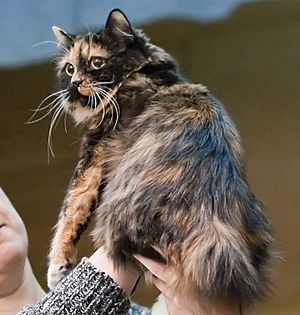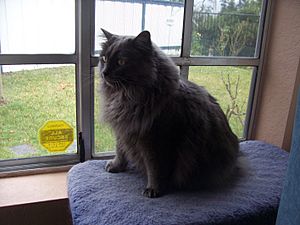Cymric cat facts for kids
Quick facts for kids Cymric |
|
|---|---|
 |
|
| Other names | Manx Longhair, Longhair Manx, Semi-longhair Manx Variant, long-haired Manx |
| Origin | Canada (breeding programme), Isle of Man (Manx stock) |
| Breed standards | |
| CFA | standard |
| FIFe | standard |
| TICA | standard |
| WCF | standard |
| AACE | standard |
| ACF | standard |
| ACFA/CAA | standard |
| CCA-AFC | standard |
| CCC of A | standard |
| CFF | standard |
| GCCF | standard |
| LOOF | standard |
| NZCF | standard |
| SACC | standard |
| Notes | |
|
Whether recognized as a separate Cymric breed, a Cymric sub-breed of Manx or simply a coat length variant of Manx, varies from registry to registry.
|
|
| Domestic cat (Felis catus) | |
The Cymric (pronounced KIM-rik or KUM-rik) is a type of domestic cat. It looks a lot like the Manx cat, but with longer fur. Some cat groups see the Cymric as just a long-haired version of the Manx. Others consider it its own special breed. Even in the same litter, you might find both short-haired Manx and long-haired Cymric kittens!
The name "Cymric" comes from Cymru, the Welsh name for Wales. However, this cat breed doesn't actually come from Wales. Its ancestors, the Manx cats, came from the Isle of Man. But the long-haired Cymric was developed in Canada. Some people call this cat the Longhair Manx.
Contents
History of the Cymric Cat
How the Cymric Cat Began
The Manx cat, which the Cymric comes from, is famous for having no tail. This special trait started as a natural change, or mutation, among cats on the Isle of Man. Because the island is a small, closed environment, this trait easily passed from one cat generation to the next. The gene for long hair also spread this way.
For a long time, long-haired kittens born to Manx cats were not wanted by breeders. They were seen as "mutants" and often discarded.
The Rise of the Cymric
In the 1960s, similar long-haired kittens were born in Canada. This time, breeders decided to keep and breed them on purpose. This was the start of the Cymric's popularity.
It took many years for the Cymric to be officially recognized as its own breed by cat associations. The Manx cat was recognized in the 1920s. But the Cymric wasn't shown at cat shows until the 1960s. It really started to become popular in the mid-1970s.
Official Recognition
Many cat organizations now recognize the Cymric as a separate breed. These include the Fédération Internationale Féline (FIFe), World Cat Federation (WCF), American Association of Cat Enthusiasts (AACE), and Canadian Cat Association (CCA-AFC).
Other groups, like The International Cat Association (TICA), recognize the Cymric by name. But they see it as a type of Manx, not a completely separate breed. The Cat Fanciers' Association (CFA) and the Governing Council of the Cat Fancy (GCCF) also consider it a long-haired Manx. They call it the Manx Longhair or Semi-longhair Manx Variant.
What a Cymric Cat Looks Like
The Cymric is a strong, medium to large-sized cat. It usually weighs between seven and thirteen pounds. They have a solid body and look very rounded. Cymrics have big, full eyes and ears that are set far apart.
Unlike the Manx, the Cymric has medium-long, thick fur. This fur is well-padded over its body, making it look even more rounded. Cymrics can come in all the same colors and patterns as Manx cats.
Different Tail Types
Cymric cats can be born with four different tail types:
- Rumpy: This is the most special type for cat shows. These cats are born completely without a tail. They often have a small dimple where the tail would normally be.
- Rumpy-riser: These cats have a very short "knob" of a tail. It is made of one to three small bones connected to the spine.
- Stumpy: Stumpies have a short tail stump. This can be up to about one-third the length of a normal cat's tail.
- Longie or Fully Tailed: These cats have tails that are as long, or almost as long, as a regular cat's tail.
It's impossible to know what tail types will appear in any litter of Cymric kittens.
Isle of Man Longhair (Tailed Cymric)
The Isle of Man Longhair is basically a Cymric cat with a full tail. It has all the features of a Cymric but does not show the tailless gene. Only the New Zealand Cat Fancy (NZCF) currently recognizes it as a separate breed.
In other cat groups, these tailed Cymrics are called "Tailed Cymric" or "Tailed Manx Longhair." They are important for breeding. This is because breeding two tailless Manx or Cymrics together can lead to health problems in the kittens. These tailed cats cannot be shown in most cat shows.
Health of Cymric Cats
The gene that causes Cymric and Manx cats to have unusual tails can also cause health issues. Kittens who get two copies of the tailless gene from their parents usually do not survive. They die before birth. This is why Cymric litters are often small.
Cats who inherit only one copy of the gene can sometimes have a condition called Manx syndrome. This can cause problems with their spine, like spina bifida. It can also lead to issues with their bladder or bowels. Sometimes, Cymric cats might have a rabbit-like hop because of their spinal shape.
Not every Cymric with a short spine will have these problems. It's just a possible effect of the Manx gene. Since these health issues usually appear within the first six months, breeders often keep Cymric and Manx kittens longer. This ensures the kittens are healthy before they go to new homes.
Some cat organizations have special breeding rules for Manx cats, including Cymrics. These rules are in place to help protect the cats' health and well-being.


